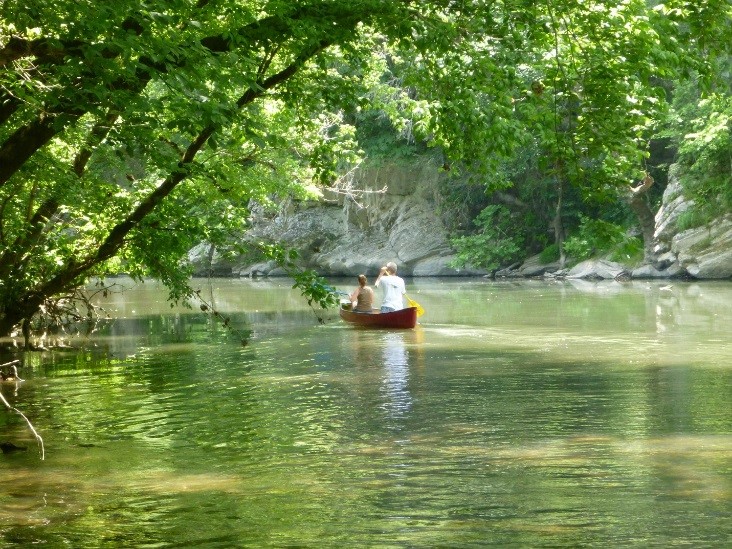From restoring the sagebrush sea to rejuvenating watersheds and landscapes after fires, ecosystem restoration can bear substantial economic fruit for local, state and national economies, according to a U.S. Geological Survey (USGS) study published today.
USGS economists evaluated 21 Department of the Interior restoration projects and found that for each dollar invested in ecosystem restoration, there was a two- to three-fold return in economic activity that rippled through local, regional and national economies. Case study projects include restoration activities associated with Natural Resource Damage Assessment sites and Bureau of Land Management sagebrush and sage-grouse habitat restoration, fuels reduction and post-fire restoration projects.
“Based on case study results, we found that for every $1 million invested in ecosystem restoration, between $2.2 and $3.4 million flow through to the U.S. economy, demonstrating how such investments support jobs and livelihoods, small businesses and rural economies,” said USGS economist and lead author Catherine Cullinane Thomas.
The report quantified methods to provide economic impact analyses focused on the jobs and business activity generated through money spent on ecosystem restoration activities. The research was a joint project among the USGS, the DOI Natural Resource Damage Assessment and Restoration Program, the DOI Office of Policy Analysis, and the BLM Socioeconomics Program.
“This report highlights the importance of restoration activities not only for the benefit of natural resources impacted by oil spills or hazardous chemicals, but also for the economic well-being of human communities,” said Steve Glomb, director of the DOI Office of Restoration and Damage Assessment.
“The study shows that these collaborative projects sustain our local economies in addition to restoring our nation’s public lands and resources,” said Josh Sidon, a BLM economist and study co-author.
Economic impacts are reported as job-years, a measure of the total number of annualized full and part-time jobs accumulated over the duration of the restoration project. Labor income is a measure of the wages and salaries earned through the jobs supported by project expenditures. Value added is a measure of the contribution to Gross Domestic Product. Economic output is a measure of the total value of the production of goods and services supported by project expenditures.
Highlighted Case Studies:
Sagebrush Steppe Restoration in South Beaver Area, Utah
Through Utah’s Watershed Restoration Initiative, the BLM and other federal, state and local agencies and organizations teamed up to help restore and manage high-priority ecosystems in Utah, including portions of Colorado Plateau and Great Basin. WRI partners are providing better wildlife habitat, restoring critical watersheds and reducing the risk of wildfire to urban communities. To date, WRI partners have restored more than 1.1 million acres in Utah. Sagebrush restoration in the South Beaver area is one of many WRI projects. This area is crucial mule deer winter habitat, contains important elk habitat and historic sage-grouse habitat. Restoration in this area is ongoing and encompasses 145,000 acres.
Total cost of restoration: $3.5 million, an estimated 72 percent spent locally in Beaver, Garfield, Iron, Kane and Washington counties in Utah.
Local economic impacts:
- Labor income: $1.9 million
- Local economic output: $4.2 million
- Contribution to GDP: $2.5 million
- Job-years: 37
Regional economic impacts:
- Labor income: $3.5 million
- Regional economic output: $8 million
- Regional contribution to GDP: $4.6 million
- Job-years: 59
Burley Landscape Sage-Grouse Habitat Restoration
The area surrounding the BLM’s Burley Field Office in Idaho is home to a variety of species, such as the greater sage-grouse, mule deer, antelope, bighorn sheep and pygmy rabbit. In the late 1800’s, with the settlement of the west, this landscape began to shift from a sagebrush steppe ecosystem to woodlands dominated by Utah juniper and conifers, decreasing available habitat for sagebrush-dependent species such as the sage-grouse and mule deer.
Total cost of restoration: $1.4 million
Local economic impacts:
- Labor income: $300,000
- Local economic output: $450,000
- Contribution to GDP: more than $310,000
- Job-years: 8
Regional economic impacts:
- Labor income: $1.6 million
- Regional economic output: $3.1 million
- Contribution to GDP: $1.9 million
- Job-years: 42
Crab Orchard National Wildlife Refuge (Crab Orchard NWR): Wastewater Treatment Plant Remediation and Restoration
The Crab Orchard National Wildlife Refuge in southern Illinois has a unique history of industry, employment and restoration. During World War II, the War Department established the Illinois Ordnance Plant on the site to manufacture ammunition and bombs. Following the war, the land was transferred into the National Wildlife Refuge System. In 1987, because of extensive environmental contamination from the ordnance plant and other industrial tenants, the U.S. Environmental Protection Agency designated the industrial complex as a Superfund site. The wastewater treatment plant on the Crab Orchard NWR is one of 21 sites on the refuge that have been remediated.
Total cost of restoration of wastewater treatment plant: $9 million, more than a third spent in local economy
Local economic impacts:
- Labor income: $1.8 million
- Local economic output: nearly $5 million
- Contribution to GDP: contributed $3 million
- Job-years: 32
National economic impacts:
- Labor income: nearly $9 million
- National economic output: $22 million
- Contribution to GDP: more than $13 million
- Job-years: 139

